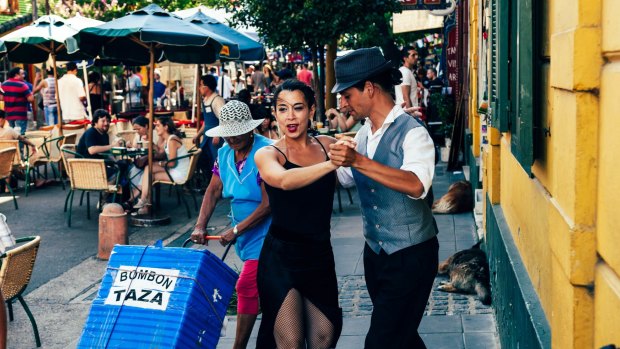This was published 4 years ago
Where to see Argentinian tango at its finest
By Brian Johnston

Tango dancers performing in the streets of Buenos Aires.Credit: Shutterstock
Ah, the tango! They say this wistful, seductive dance captures Argentina's soul. In the neighbourhoods of Buenos Aires, locals tango in evening shadows, accompanied by haunting accordion music and the raspy voices of old men. In the city's tango clubs the music swells, dancers' shoes rattle the stage, and applause rises like a great unrequited sigh.
The tango isn't just music or a dance but the passion of Argentina. Tango shows provide dazzling technical displays, but the rough emotion of street tango is its best expression. Sit in Plaza Dorrego in Buenos Aires' bohemian San Telmo neighbourhood and the sob of the accordion and click of dancers' feet on cobblestones will transport you.
The tango is a 19th-century dance form that emerged from poor immigrant quarters of the capital such as La Boca. Like jazz, tango was an improvisational musical style originally heard in working-class bars and brothels. Like jazz, it has a mixed heritage, with elements of African, Cuban, Spanish and Polish dances. The accordion that accompanies it was introduced by German immigrants.
Originally a dance for two men, tango took on a more passionate character in the 1870s under the influence of another sensual, risque Argentine dance, the milonga. Its lyrics still dealt with immigrant subjects such as politics and exile, however. One of the great artists of tango music was Carlos Gardel, a French immigrant who became an Argentine legend after he was killed in a 1935 plane crash at the height of his fame.
Stroll around La Boca, where some say tango was invented, and immigrant influences are still apparent. Its houses are painted in soccer-team colours. Others are adorned with frescoes showing tango and scenes from the lives of the mostly Italian immigrants who arrived here after World War II. Tango dancers perform for the tourists, and street artists paint tango scenes. Once I saw two tango dancers paint their shoe soles with black and red paint, then twirl across scrolls of paper laid down in the street, forming designs of abstract paint and passion.
"A tango is a sad thought that dances," said famous tango composer Enrique Santos Discepolo. Only some tango is about abandoned lovers or the cruel inattention of beautiful women. Tango is the cultural-fusion music of the marginalised, with lyrics of social protest and satire. The tango is sorrow and sadness, irony and humour, with a rhythm to make emotions quiver.
Sign up for the Traveller newsletter
The latest travel news, tips and inspiration delivered to your inbox. Sign up now.